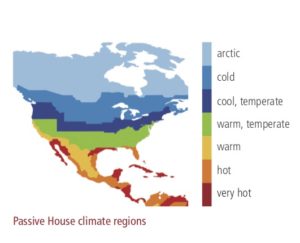Energy efficiency and high comfort.
The Passive House Standard provides high energy efficiency, as well as high quality and high comfort. The components of each Passive House building must be selected to meet the energy targets, as well as to ensure a comfortable indoor environment. Suitable component qualities can effectively be identified with the Passive House Planning Package (PHPP) during the various design stages.
Indoor comfort
The comfort level in a building during winter is significantly influenced by the temperatures of all surfaces surrounding us. A person will feel comfortable only if the coldest surface in the room is not significantly below the perceived room tempera- ture (less than 4.2 K or 7.6 °F difference). There will be no cold downdraughts causing cold feet or radiant heat losses towards the cold surface.
 The thermal performance of windows used in a Passive House building must therefore be selected carefully to ensure a minimum surface temperature (so-called ̏comfort criterion ̏). This functional requirement depends largely on the outside climate conditions of where the building is being built.
The thermal performance of windows used in a Passive House building must therefore be selected carefully to ensure a minimum surface temperature (so-called ̏comfort criterion ̏). This functional requirement depends largely on the outside climate conditions of where the building is being built.
Given an outside design temperature of -12 °C or 10.4 °F in the climate of New York City (according to PHPP), the installed windows must fulfill the following thermal specifications:
U-Value below 0.95 W/(m2K) | 0.167 BTU/(hr.ft2.°F) Windows used in Passive House buildings in New York City will thus be triple-glazed with a warm edge bond.
Two strategies are possible:
- Combining a highly insulated window frame
(e.g certified for the cool, temperate climate) with typical triple-glazing. - Combining a less insulated window frame
(e.g. certified for the warm, temperate climate) with highly insulating triple-glazing.
 When selecting a window frame for a project, higher performance (i.e. Strategy 1) is strongly recommended as a general approach, as it provides a significantly more robust solution in terms of both performance and comfort. The glazing specifications often change during detailed planning stages (e.g. for fire & security require- ments), which will compromise meeting the requirements if the window frame cannot compensate for the higher heat losses.
When selecting a window frame for a project, higher performance (i.e. Strategy 1) is strongly recommended as a general approach, as it provides a significantly more robust solution in terms of both performance and comfort. The glazing specifications often change during detailed planning stages (e.g. for fire & security require- ments), which will compromise meeting the requirements if the window frame cannot compensate for the higher heat losses.
Certified windows and respective specifications are listed on the component database: www.componentdatabase.org

























